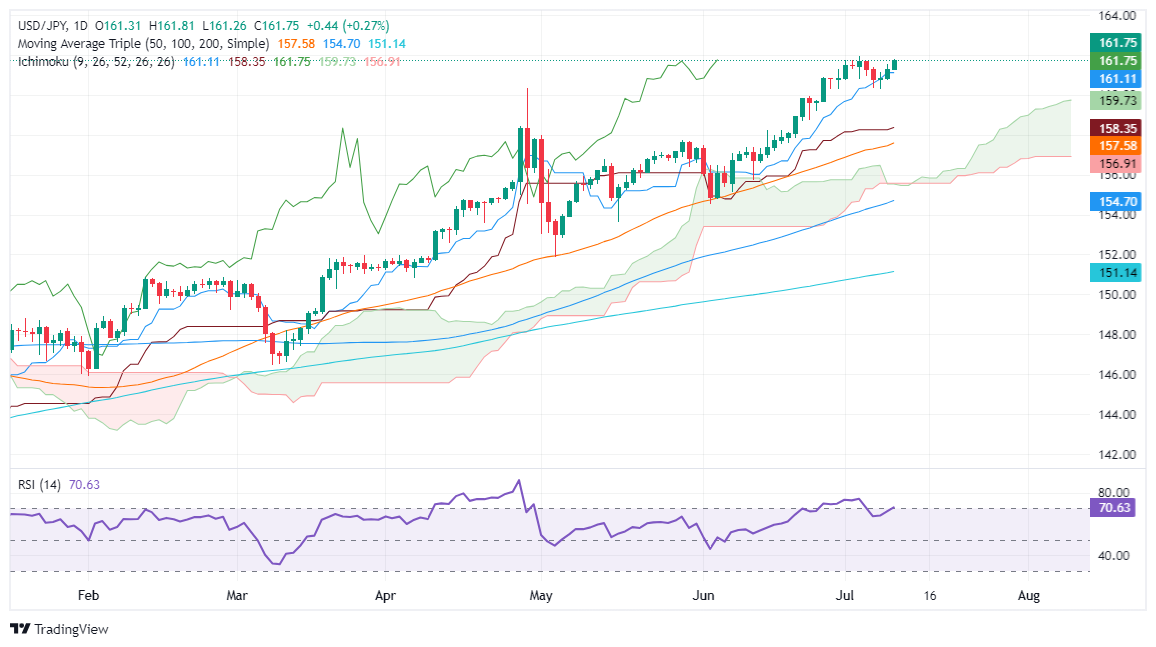- USD/JPY gains more than 0.30%, boosted by Powell’s stance against rate cuts without clear disinflation.
- Technicians are targeting resistance near the 162.00 mark; the RSI is approaching overbought territory.
- Support Levels to Watch: 161.10 (Tenkan-Sen), 160.73 (July 9 Low), 160.26 (July 8 Low) if the bears take control.
He USD/JPY The pair extended its advance for a third straight day and posted gains of over 0.30% as Fed Chair Jerome Powell stuck to the script. He said that cutting the federal funds rate is not an option unless there is progress in the disinflation process. The pair is trading at 161.77, approaching the yearly high of 161.95.
USD/JPY Price Analysis: Technical Outlook
From a technical perspective, the USD/JPY uptrend remains intact, although sellers could emerge around the psychological resistance level of 162.00.
Momentum indicates a buyer-dominated market; the RSI is hovering near overbought conditions. This could hamper the bulls’ momentum to lift the USD/JPY exchange rate or pave the way for consolidation.
If USD/JPY decisively breaks above 162.00, the next resistance would be 163.00, and the November 1986 high of 164.87.
Conversely, if the bears step in and drag prices below the Tenkan-Sen at 161.10, it could exacerbate a deeper pullback. The next support would be the July 9 low of 160.73, followed by the July 8 last cycle low of 160.26. If those two levels are breached, USD/JPY could be set for a drop to 160.00 and below.
USD/JPY Price Action – Daily Chart
Japanese Yen FAQs
The Japanese Yen (JPY) is one of the most traded currencies in the world. Its value is determined broadly by the performance of the Japanese economy, but more specifically by the policy of the Bank of Japan, the spread between Japanese and US bond yields, and risk sentiment among traders, among other factors.
One of the Bank of Japan’s mandates is currency control, so its moves are key to the Yen. The BoJ has intervened directly in currency markets on occasion, usually to lower the value of the Yen, although it often refrains from doing so due to political concerns of its major trading partners. The BoJ’s current ultra-loose monetary policy, based on massive stimulus to the economy, has caused the Yen to depreciate against its major currency peers. This process has been exacerbated more recently by a growing policy divergence between the BoJ and other major central banks, which have opted to sharply raise interest rates to combat decades-old levels of inflation.
The Bank of Japan’s stance of maintaining an ultra-loose monetary policy has led to an increase in policy divergence with other central banks, in particular with the US Federal Reserve. This favours the widening of the spread between US and Japanese 10-year bonds, which favours the Dollar against the Yen.
The Japanese Yen is often considered a safe haven investment. This means that in times of market stress, investors are more likely to put their money into the Japanese currency due to its perceived reliability and stability. In turbulent times, the Yen is likely to appreciate against other currencies that are considered riskier to invest in.
Source: Fx Street
I am Joshua Winder, a senior-level journalist and editor at World Stock Market. I specialize in covering news related to the stock market and economic trends. With more than 8 years of experience in this field, I have become an expert in financial reporting.








